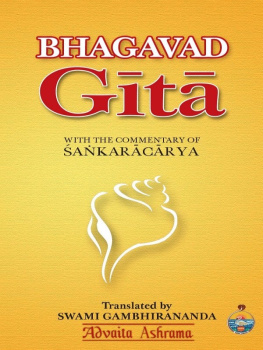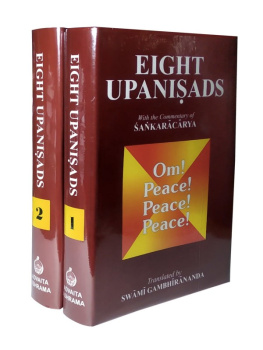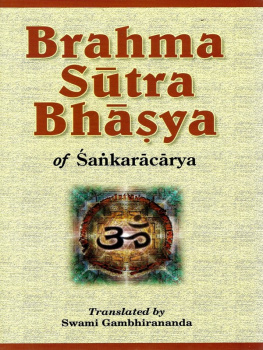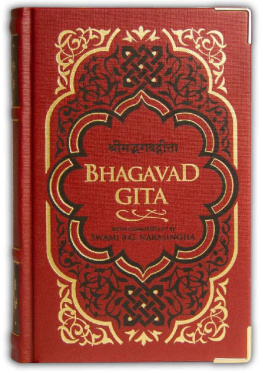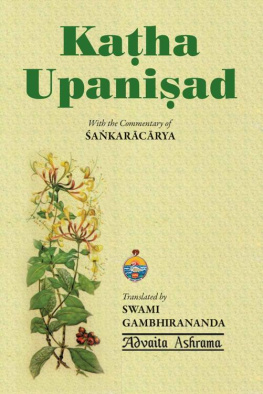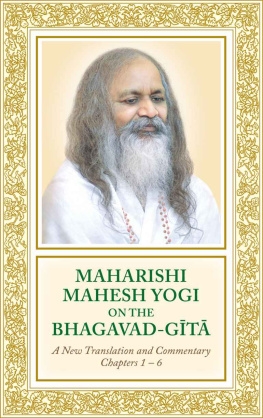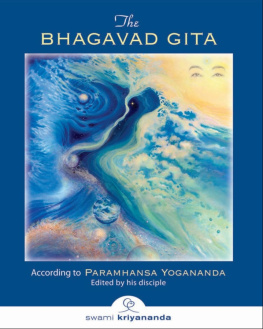Published by
The Adhyaksha
Advaita Ashrama
P.O. Mayavati, Dt. Champawat
Uttarakhand - 262524, India
from its Publication Department, Kolkata
Email: mail@advaitaashrama.org
Website: www.advaitaashrama.org
All Rights Reserved
Second Print Edition, April 2018
First Ebook Edition, July 2018
ISBN 978-81-7505-aaa-a (Paperback)
ISBN 978-81-7505-418-9-aaa-a (Ebook)
PUBLISHERS NOTE
TO THE SECOND EDITION
The present English translation of the Bhagavad Gita along with the commentary of Shri ankarcrya by Swm Gambhrnanda, the 11th President of the Ramakrishna Order, has been widely accepted as one of the most authentic translations. We are pleased to present this fully revised and computerised second edition as per the modern printing standards. Hope this will be warmly received by the readers as the previous edition.
P UBLISHER
April 2018
PUBLISHERS NOTE
TO THE FIRST EDITION
The publication of this edition of the Bhagavad gt by us fulfils a long-felt need, namely, to make available to the public interested in Advaita Vednta a faithful English translation of ankarcryas commentary on this sacred scripture. It is well known that the Gt is one of the constituents of the prasthna-traya , three source-books, of the Vednta Darana. It is called the smrti-prasthna , as it forms a part of the great epic, the Mahbhrata .
The translator, Swm Gambhrnanda, one of the Vice Presidents of the Ramakrishna Math and the Ramakrishna Mission, needs no introduction to those who have studied his Eight Upanisads (in two volumes, each of which is also separately published), his Brahma-Stra-Bhsya of ankarcrya , published nearly two decades back, and his Chndogya Upanisad , published recentlyall by the Advaita Ashrama, Mayavati. He now offers this translation of the bhsya of ankarcrya on this very important scripture, Bhagavadgt , which, as the translator remarks in his valuable Introduction, is ranked among the greatest religious books of the world. In this informative and scholarly Introduction, he has discussed in brief such subjects as the date of the Mahbhrata war, which provided the occasion for the birth of the Gt , the historicity of the Gtcrya Krishna, the importance and influence of the Gt on other countries, the date of ankarcryawell documented and fortified by the views of several savants, both of the East and the West, and by referring to inscriptions.
The method followed in translating this bhsya is the same as in his translation of the Upanisads. With the publication of this book, the present translator has done the monumental work of rendering into English ankarcryas bhsya on the entire gamut of the prasthna-traya , with the only exception of the Brhadranyaka Upanisad, the commentary on which by ankara was translated by Swm Mdhavnanda of revered memory and first published by us in July 1934.
It may be noted that, while the lokas are in devangar , only the English rendering of such expressions as ShriBhagavnuvca , Arjuna uvca , are given in the book. A very useful feature of this edition of the Bhagavadgt is the inclusion of a Word Index to the entire text, apart from an Index to the first words of the lokas , which, we believe, will be found helpful to both scholars and students alike. It is our earnest hope that this edition of the Gt will be warmly welcomed and received by those interested in ankarcryas commentary on it.
P UBLISHER
Janmsam
Advaita Ashrama
19 August 1984
KEY TO TRANSLITERATION
AND PRONUNCIATION
Sounds like
a
o in s o n
a in m a ster
i
i in i f
ee
in f ee l
u
u in f u ll
oo in b oo t
r
somewhat between
r and ri
e
a in ev a d
ai
y in m y
o
o in o ver
k
k
kh
ckh in blo ckh ead
g
g (hard)
gh
gh in log- h ut
n
ng
v
ch (not k)
ch
chh in cat ch him
j
j
jh
dgeh in he dgeh og
n (somewhat)
t
h
th in an t-h ill
d
h
dh in go dh ood
n
n in u n der
t
French t
th
th in th umb
d
d in th em
dh
theh in brea the here
n
n
p
p
ph
ph in loo p-h ole
b
b
bh
bh in a bh or
m
m
y
r
r
l
l
v
v in a v ert
sh
s
sh in sh ow
s
s
h
h
.
m in hu m
:
h
half h in hu h !
LIST OF ABBREVIATIONS
| .. | nanda shrama Edition |
| .G. | nanda Giri |
| p.Dh.S. | pastamba-Dharma-Stras |
| As. | Asekar Edition |
| B. S. | Brahma-Stras |
| Bh. | Shrimad Bhgavatam |
| Bo. Sm. | Bodhyana-Smrti |
| Br. | Brhadranyaka Upanisad |
| C.P.U. | A Concordance to the Principal Upanisads and Bhagavad-Gt |
| C.W. | The Complete Works of Swami Vivekananda |
| Ch. | Chndogya Upanisad |
| Gau. Sm. | Gautama-Smrti |
| G. Pr. | Gt Press (Gorakhpur) Edition |
| . | vsya Upanisad |
| J. | Jbla Upanisad |
| Ka. | Kaha Upanisad |
| Kai. | Kaivalya Upanisad |
| Ke. | Kena Upanisad |
| M.S. | Madhusudan Sarasvat |
| Ma. N. | Mahnryana Upanisad |
| Ma. Sm. | Manu-Smrti |
| Mbh.. | Mahbhrata, Avamedhika-parva |
| Mbh.. | Mahbhrata nti-parva |
| Mbh. St. | Mahbhrata Str-parva |
| Mbh. Va. | Mahbhrata Vana-parva |
| Mu. | Munaka Upanisad |
| N. Par. | Nrada Parivrjaka Upanisad |
| N. S. | Nsadya-Skta |
| Nr. P. | Nrsimha-prva-tpani Upanisad |
| Nr. Ut. | Nrsimha-uttara-tpani Upanisad |
| P. | Pacadas |
| P. Y. S. | Ptajala-Yog-Stras |
| Pr. | Prana Upanisad |
| Pu. S. | Purusa-skta |
| rg. | rg-veda |
| . | ankarnanda, Swm |
| .S. | Shridhara Swm |
| a. Br. | atapatha Brhmana |
| Sr. S. | Srsi-skta |
| v. | vetvatara Upanisad |
| Tai. r. | Taittirya ranyaka |
| Tai. Br. | Taittirya Brhmana |
| Tai. Sa. | Taittirya Sahit |
| V.P. | Visnu Purna |
| V.S.A. | V.S. Apte ( A Sanskrit-English Dictionary) |
| Y. | Yjik Upanisad |
INTRODUCTION
The scene of the delivery of the Bhagavadgt ( The Song Divine ), also known briefly as the Gt , by Shri Krishna to Arjuna is laid on the battlefield of Kurukshetra where the Pandavas and the Kauravas had assembled their armies for war. Scholars differ as regards the date of this battle, though they are inclined to think that it was a historical event. According to tradition, the that it was fought in 2566 BC . C. V. Vaidya holds that the war was fought in 3102 BC .
As Dhritarashtra was born blind, he could not rule the kingdom. So his younger brother Pandu became the Ruler. When Pandu died his sons were too young as also were Duryodhana, the eldest son of Dhritarashtra, and his younger brothers. Hence Bhishma, the oldest member of the family, managed the affairs of the State. When the young boys came of age Duryodhana wanted to become the King by ousting Yudhishtira through foul means. But public opinion was in favour of Yudhishtira. So, in order not to antagonize the officials and the people, Bhishma advised Dhritarashtra to divide the kingdom between his sons, referred to as the Kauravas, and Pandus sons called the Pandavas. This advice was followed. Accordingly the former ruled from Hastinpura and the latter from Indraprastha for thirty-six years. But Duryodhana was jealous of the prosperity of the Pandavas, and to ruin them he invited Yudhishtira to a game of dice, which resulted in the banishment of the Pandavas under the condition of living in the forest for twelve years and one year incognito. After the stipulated period Yudhishtira claimed his portion of the kingdom, but Duryodhana refused, and this led to the battle of Kurukshetra. Yudhishtira had four brothersBhima, Arjuna, Nakula and Sahadeva. Arjuna was considered the mightiest among the contemporary warriors. Shri Krishna, though Himself formidable warrior and regarded as an Incarnation of Bhagavn, vowed not to take up arms on either side, but agreed to become the charioteer of Arjuna. Through the political sagacity and able advice of Shri Krishna the result of the battle went in favour of Yudhishtira, who ascended the throne.
Next page
